The Beef Pasanda Recipe (Pakistani) was a favorite dry curry of the Mughal Court around the 16th Century. Beef tenderloin filets are pounded thin, and marinated with flavor enhancers, meat tenderizers, and aromatic spices. Slow-cooked till the meat is fork tender, the recipe requires very little active cooking and is easy to follow.
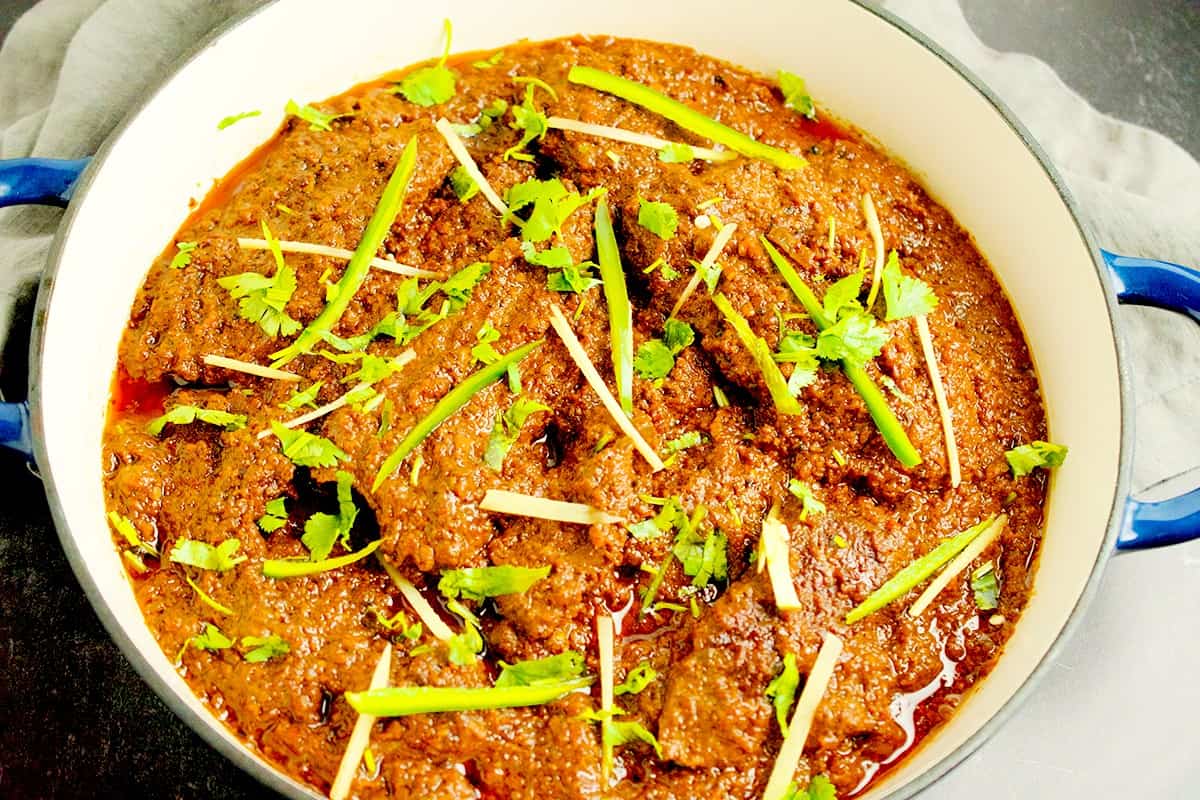
The word "Pasanda" is derived from the word "pasand", which means to like. The word is a reference to the fact that the choicest cut of meat is used for this recipe. Many variations of the beef pasanda recipe exist, such as badam pasanda, mirchi pasanda, and chicken pasanda, to name a few.
My personal favorite is these beef pasandas, served with some lentils, naan or basmati rice, and a glass of delicious mango juice. Follow this up with some refreshing kulfi for a perfect finish to dinner.
Jump to:
Why you'll love this beef pasanda recipe
- Delicious - This recipe is like nothing you've tasted before! Each pasanda is coated in a mouthwatering curry that hits all the right notes.
- Very little active cooking required - This beef pasanda recipe requires only 15 minutes and then 30 minutes of active cooking time, at two separate intervals.
- Not too spicy - The spices used are flavorful and aromatic without being spicy. This is a mild curry, relative to others like karahi gosht, haleem, or nihari.
- Make ahead recipe - The meat can be marinated well ahead of time and frozen. On the day you want to serve your beef pasanda recipe, simply defrost, fry the filets, and then slow cook to excellence.
Ingredient notes for the beef pasanda recipe
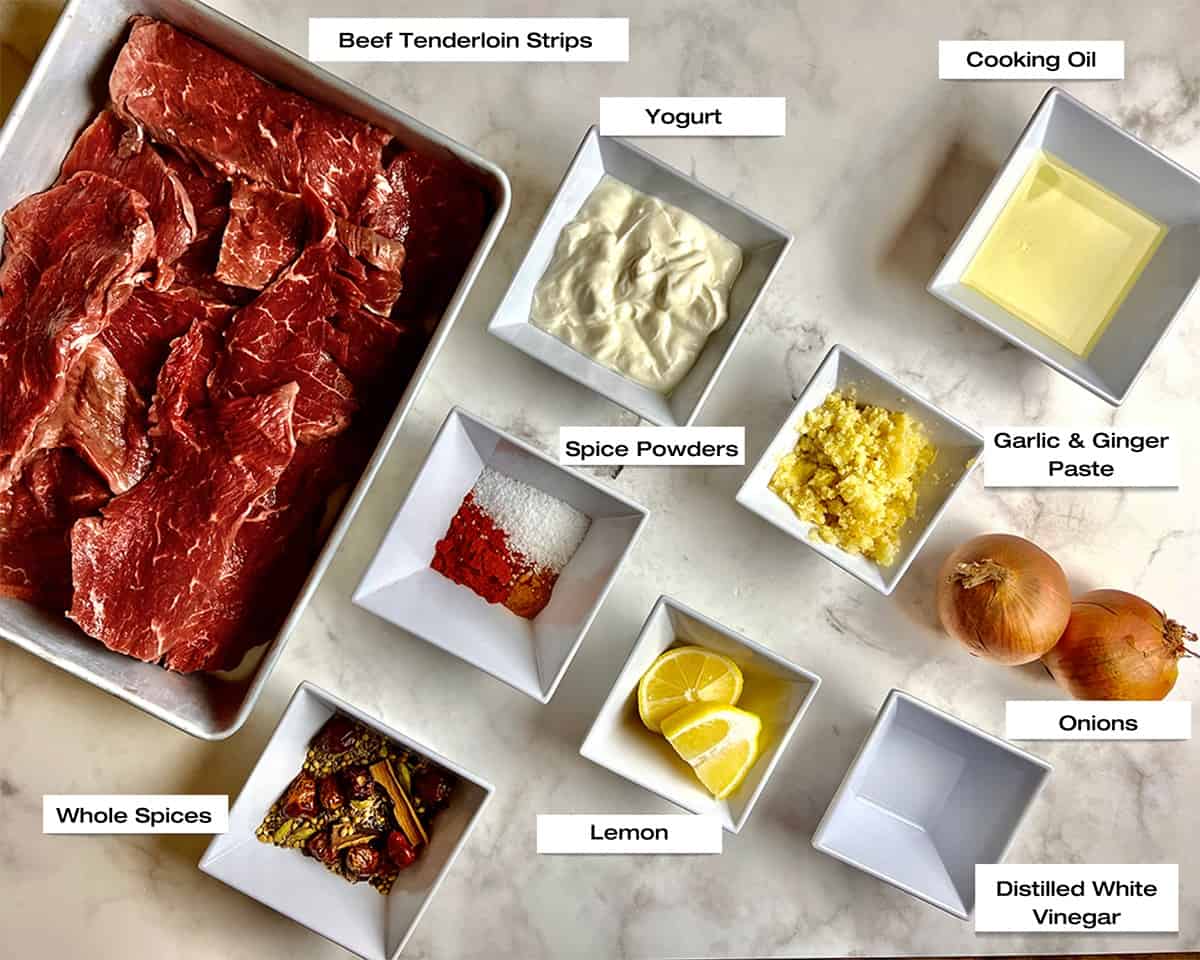
- Beef Tenderloin Strips - For this recipe buy beef tenderloin and have your butcher cut them into 2"x4" strips that are ideally ⅛" thick. The thinner the strips the better the final results, just like in Bihari Kebab. The thickest strips I've ever worked with for my pasanda recipe are ¼" thick.
- Yogurt - Full-fat plain yogurt is the best one to use due to its creamy texture. I always recommend it for all my recipes, like my chicken tikka masala.
- Vinegar - White distilled vinegar is essential as a tenderizer and for flavor.
- Lemons - These are also a tenderizer and add to the flavor.
- Whole spices - The whole spices mix to provide sweet, citrusy, floral, and pungent notes to this recipe. When mixed with creamy yogurt, nutty poppy seeds, spice powders, acidic vinegar, and lemon, the result is delectable.
Please see the recipe card at the bottom of this post for the complete list of ingredients with measurements plus recipe instructions.
Substitutions & variations
- Use papaya as a tenderizer - I like to use poppy seeds as my tenderizer as I love the nutty flavor they add. However, if you want, you can use the more traditional 2 tablespoon raw papaya paste in the pasanda marinade instead.
- Try a different meat - A leg of lamb or goat can make a great pasanda, as does chicken breast.
- Add some almonds or Cashews - Ground almonds or cashews act in the same manner as the poppy seeds, to help flavor and thicken the pasanda curry. I like the milder taste of poppy seeds as well as the fact that I don't have to worry about serving them to people with nut allergies. Feel free to swap and try nuts.
- Add some besan - many people add besan, chickpea powder, to their pasanda recipe. This is a great idea if you can't source poppy seeds and have a nut allergy. Make sure to swap with the poppy seeds. Adding both can make the curry too dry.
- Add some coconut powder - Yet another thickener that is safe for nut allergies, this tastes delicious in a pasanda curry too. Swap with the poppy seeds or add half and half of each.
Step-by-step instructions
The spice blend & marinade

- Dry roast all the spices in a nonstick frying pan. Make sure the pan is well heated and that you stir constantly while roasting to prevent the spices from burning. Turn your stove off as soon as the spices start to smoke slightly and change color.
- Cool for 30 seconds and then grind these roasted spices. A coarse consistency is what we're aiming for.
- Stir in this ground mixture with the spice powders and mix well to prepare your pasanda spice blend.
- Mix this blend with the yogurt, vinegar, lemon juice, garlic, and ginger paste.
Tenderizing & Marinating the Pasandas

- Once everything is mixed and whipped to a creamy consistency, set this marinade aside.
- Take the pasanda strips and place each one, individually on a firm surface in preparation to manually tenderize them.
- Use a meat tenderizer to pound the filets till they are twice as long and wide and half as thin.
- Then place the tenderized pasanda strips in a container and coat them with the marinade. Cover and set aside for a minimum of 4 hours and preferably overnight.
WANT TO SAVE THIS RECIPE?
Frying the beef filets

- When you're ready to cook the pasandas, shallow fry each strip of meat in a wide skillet.
- Cook till the strips are nicely browned on both sides.
- For best results, work in batches, 2-3 strips at a time, depending on the size of your strips and pan.
- This will require some patience but the pasandas will be more succulent this way. Once done, set them aside as you start preparing the curry.
Preparing the curry base

- Take the residual marinade and stir it.
- Fry some thinly sliced onions till they're well caramelized.
- Add these to the marinade and mix well.
- Puree in a food processor, blender, or by using an immersion blender.
Finishing the beef pasanda recipe

- Preheat some oil in a pan and add this puree to it.
- Add 2 cups of water to create a liquid mixture.
- Cover and slow-cook the browned meat slices in this till the pasanda meat is tender enough to separate with a fork.
- The pasanda curry is on the dry side so once the meat is cooked, uncover and cook till all the water evaporates and the gravy just coats the meat.
Expert Tips
- Source the right meat - Getting the right meat and having it cut the right way is instrumental to the success of this pasanda recipe. If you go to a Pakistani butcher you can simply tell them you need meat for Pasanda and they'll give you the proper cut, sliced thin. If that isn't an option, go to the meat counter at your local supermarket, ask for tenderloin, and specify how you need the meat sliced.
- Marinate overnight - For best results, pound your pasanda filets thin and marinate them overnight. It's also possible to buy the meat, prep it, marinate it, and freeze it till you need it. On the day you want to serve it, simply fry the filets and prepare the curry.
- Slow-cook it - This is traditionally a slow-cooked recipe, just like my tandoori beef roast and my roast leg of goat recipes. Although you are welcome to use your Instant Pot or pressure cooker to speed up the process, the flavor of your Pasanda recipe will be best if slow-cooked.
Recipe FAQS
Pasanda is a curry made with paper-thin slices of beef, lamb, or goat meat. The meat is first cut into thin slices and then pounded even thinner with a meat mallet. The dry curry coats the beef filets known as "parcha" which means a piece of paper. This beef pasanda recipe is delicious and aromatic without being too spicy.
Traditionally, Pasanda was marinated with a dried wild melon known as Kachri. This melon has a tangy pungent taste and acts as a meat tenderizer. Kachri powder is available through specialty stores, but I find that using vinegar and poppy seeds in my masala and marinade is a much easier way to replicate the traditional taste of Kachri. The vinegar acts as a tenderizer and gives a slightly sour taste similar to that of Kachri or Amchur. The poppy seeds provide the texture and protein that the ground melon would provide.
Leftovers can be stored in the fridge for 3-5 days and can be frozen in an airtight container for up to 6 weeks. To reheat, add a little water and steam on low in a covered pot on your stove.
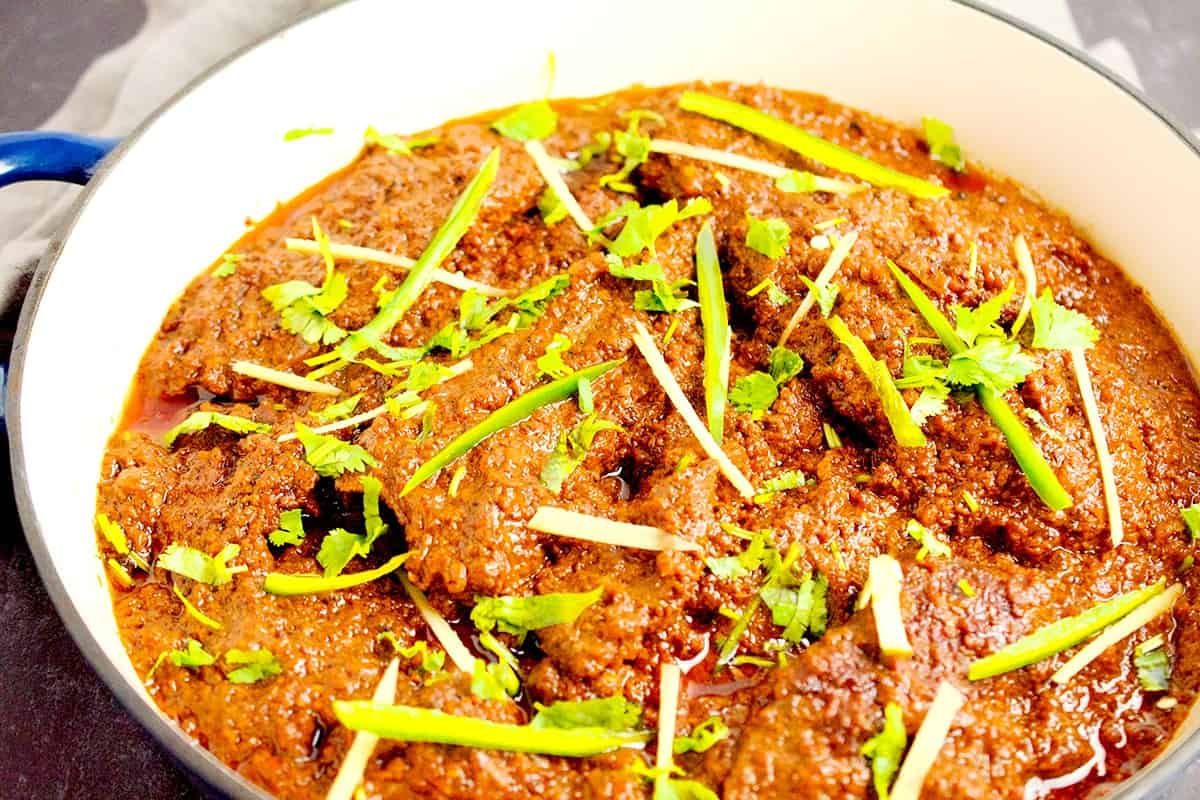
Other meat recipes you may like
For more Pakistani recipes like this, check out 20 popular Pakistani recipes. If you decide to try this recipe, Please don't forget to leave a rating and comment below! If you take a picture then tag me on Instagram! Thank You!
Beef Pasanday Recipe
WANT TO SAVE THIS RECIPE?
Ingredients
Pasanda Masala (For 2 lb Meat)
- 1 teaspoon peppercorn
- 2 teaspoon coriander seeds
- 2 teaspoon cumin seeds
- 2 teaspoon black mustard seeds
- 1 teaspoon cloves
- 1 tsp green cardamom
- 2 inch cinnamon stick
- 10 dried red chilies
- 2 tablespoon poppy seeds
- 2 teaspoon salt (adjust to taste)
- ½ teaspoon turmeric
- 2 teaspoon red chili powder (adjust to taste)
Marinade (For 2 lb Meat)
- 1 cup plain full fat yogurt
- 2 teaspoon lemon juice (1 large lemon)
- 2 teaspoon vinegar
- 1 tablespoon ginger paste
- 1 tablespoon garlic paste
- Pasanda Masala per recipe above
Pasanday
- 2 lb beef tenderloin strips (see notes)
- pasanda marinade per recipe above
- 1 cup oil
- 2 onions
- 2 cup water
Garnish (For 2 lb Meat)
- ½ inch piece ginger
- ½ cup cilantro
- 4 serrano chillies
Instructions
Pasanda Masala
- Dry roast all the whole spices for a few minutes, just till you can smell a nutty aroma. Be careful not to over roast them or else the curry will have a burnt taste.
- Cool slightly and grind to a powder using a spice grinder.
- Add in all the powdered spices, mix well, and set aside.
Marinade
- Beat the yogurt, lemon juice, vinegar, garlic, ginger and pasanda masala to prepare the marinade.
Pasanday
- The beef tenderloin should be cut into very thin strips, about 2 x 4 inches long and ⅛ inch thick. (see notes)
- Using a mallet pound the beef to help tenderize it (see notes)
- Marinate it overnight using the prepared marinade. (see notes)
- The next morning, remove the meat strips from the marinade (reserving the marinade for later), heat about ½ cup of the oil, and lightly brown the meat on both sides.
- Dice the two onions and saute in the remaining ½ cup oil until well browned.
- Remove them from the oil (reserving the oil), add to the marinade, and grind to a paste.
- Add this puree to ¼ cup of the reserved oil along with 2 cups of water and add the fried strips of meat.
- Cover and bring this mixture to a boil, and then reduce the heat to a simmer.
- Cook for 30 minutes, and then check to see if the meat is cooked through (see notes).
- Uncover, turn the flame on high to dry all the excess liquid until you're left with a thick dry gravy that just coats the meat.
- garnish with sliced green chilies, ginger and cilantro and serve with fresh, hot naan
Notes
- Seasoning - Salt and chilies are spices that often need adjustment to personal taste. I tend to keep them on the lower side in my recipes, as more can always be added, but too much can be a problem. I recommend tasting the curry towards the end of the cooking process and adjusting it to suit your taste.
- Lemon - One large lemon is approximately equal to 2 teaspoons.
- Meat - In Pakistan, we get a specific cut of meat called "undercut" for pasandas, and the butcher usually trims it and cuts it into perfectly sized pieces. The best I've found here in the USA is tenderloin. If you can access a good butcher who will slice it into thin 2x4 strips, that's perfect! If not, grab a good knife and do the best you can! The thinner the strips, the better!
- Tenderizing - Even though the strips are cut thin, they must be tenderized. The best way to do that is to use the rough side of a meat mallet to pound them till they're half as thin and double in size.
- Cooking Time - If the meat is of good quality and has been cut as specified, it should be done in the time stipulated. However, conditions such as the stove you're using, the cooking pot, and the actual meat itself all play a role in the final results. Use your best judgment to decide when the meat is done.


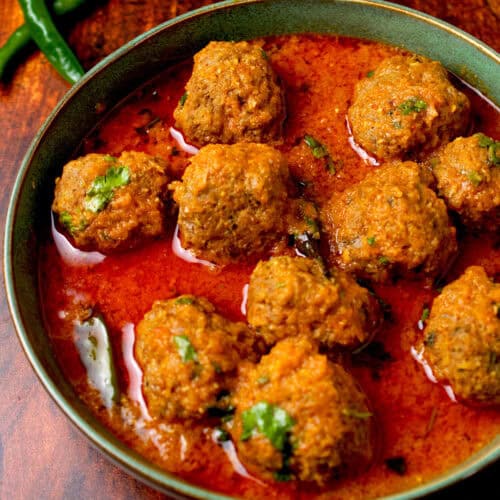
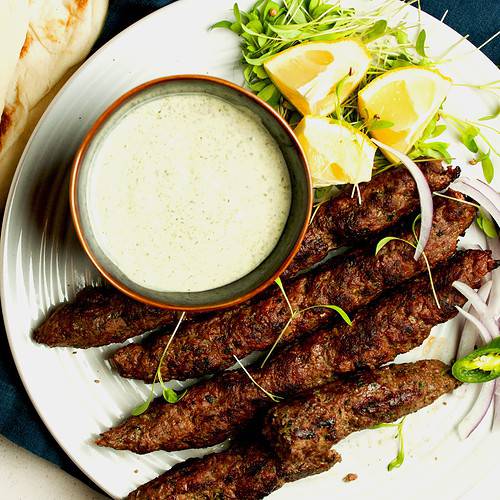
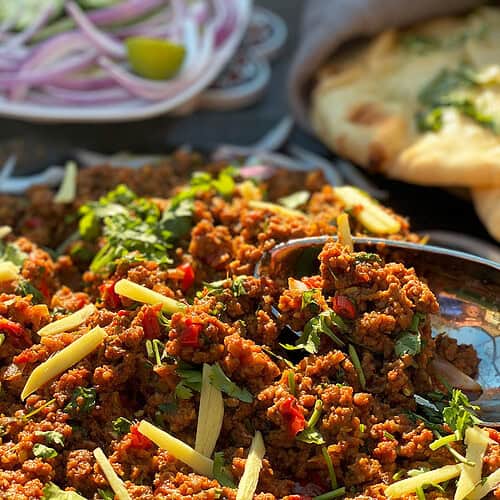
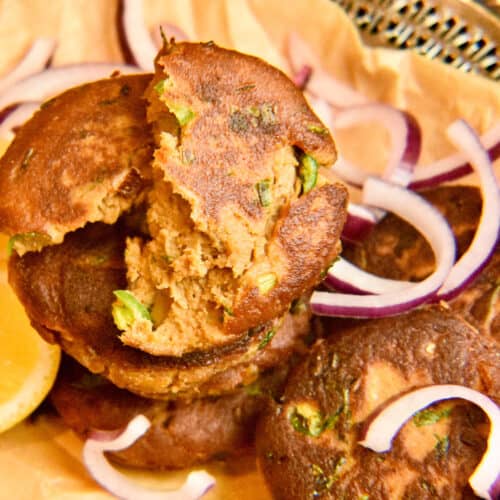
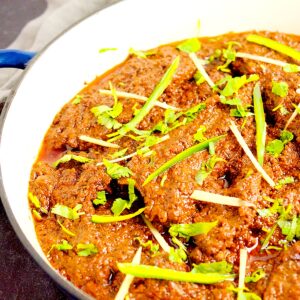



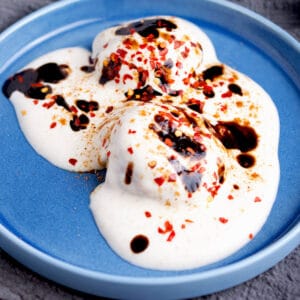
Zeenat
Wonderful recipe ! Original Mughal recipe ! Amazing and great ! I will try to cook InshaaAllah and leave notes for you
untoldrecipesbynosheen
Thank You Zeenat! Can't wait for you to try it and give me your feedback!